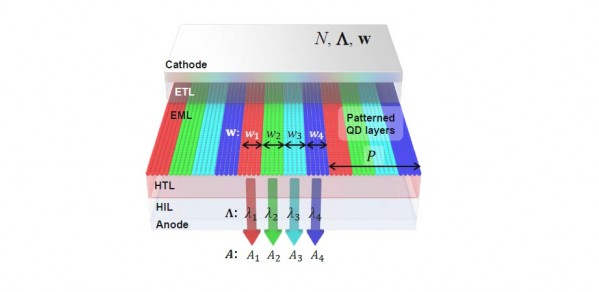
Researchers have designed smart, colour-controllable white light devices from quantum dots, tiny semiconductors just a few billionths of a metre in size, which are more efficient and have better colour saturation than standard LEDs, and can dynamically reproduce daylight conditions in a single light.
The ability to better reproduce daylight through its varying colour spectrum dynamically in a single light is what we aimed for, we achieved it in a new way through using quantum dots. This research opens the way for a wide variety of new human responsive lighting environments.
Professor Gehan Amaratunga
The researchers, from the Department's Electrical Engineering division, designed the next-generation smart lighting system using a combination of nanotechnology, colour science, advanced computational methods, electronics and a unique fabrication process.
They found that by using more than the three primary lighting colours used in typical LEDs, they were able to reproduce daylight more accurately. Early tests of the new design showed excellent colour rendering, a wider operating range than current smart lighting technology, and wider spectrum of white light customisation.
As the availability and characteristics of ambient light are connected with wellbeing, the widespread availability of smart lighting systems can have a positive effect on human health since these systems can respond to individual mood. Smart lighting can also respond to circadian rhythms, which regulate the daily sleep-wake cycle, so that light is reddish-white in the morning and evening, and bluish-white during the day.
When a room has sufficient natural or artificial light, good glare control, and views of the outdoors, it is said to have good levels of visual comfort. In indoor environments under artificial light, visual comfort depends on how accurately colours are rendered. Since the colour of objects is determined by illumination, smart white lighting needs to be able to accurately express the colour of surrounding objects. Current technology achieves this by using three different colours of light simultaneously.
Quantum dots have been studied and developed as light sources since the 1990s, due to their high colour tunability and colour purity. Due their unique optoelectronic properties, they show excellent colour performance in both wide colour controllability and high colour rendering capability.
The Cambridge researchers developed an architecture for quantum-dot light-emitting diodes (QD-LED) based next-generation smart white lighting. They combined system-level colour optimisation, device-level optoelectronic simulation, and material-level parameter extraction.

TEM images of the red, green, cyan, and blue QDs used for device fabrication and charge transport simulation.
The researchers produced a computational design framework from a colour optimisation algorithm used for neural networks in machine learning, together with a new method for charge transport and light emission modelling.
The QD-LED system uses multiple primary colours – beyond the commonly used red, green and blue – to more accurately mimic white light. By choosing quantum dots of a specific size – between three and 30 nanometres in diameter – the researchers were able to overcome some of the practical limitations of LEDs and achieve the emission wavelengths they needed to test their predictions.
The team then validated their design by creating a new device architecture of QD-LED based white lighting. The test showed excellent colour rendering, a wider operating range than current technology, and a wide spectrum of white light shade customisation.
The Cambridge-developed QD-LED system showed a correlated colour temperature (CCT) range from 2243K (reddish) to 9207K (bright midday sun), compared with current LED-based smart lights which have a CCT between 2200K and 6500K. The colour rendering index (CRI) – a measure of colours illuminated by the light in comparison to daylight (CRI=100) – of the QD-LED system was 97, compared to current smart bulb ranges, which are between 80 and 91.
The design could pave the way to more efficient, more accurate smart lighting. In an LED smart bulb, the three LEDs must be controlled individually to achieve a given colour. In the QD-LED system, all the quantum dots are driven by a single common control voltage to achieve the full colour temperature range.
“This is a world-first: a fully optimised, high-performance quantum-dot-based smart white lighting system,” said Professor Jong Min Kim from Cambridge’s Department of Engineering, who co-led the research. “This is the first milestone toward the full exploitation of quantum-dot-based smart white lighting for daily applications.”

Voltage-dependent chromaticity variations of the fabricated lighting systems with identical (green dots) and optimised (blue dots) emission pattern widths.
“The ability to better reproduce daylight through its varying colour spectrum dynamically in a single light is what we aimed for,” said Professor Gehan Amaratunga, who co-led the research. “We achieved it in a new way through using quantum dots. This research opens the way for a wide variety of new human responsive lighting environments.”
The structure of the QD-LED white lighting developed by the Cambridge team is scalable to large area lighting surfaces, as it is made with a printing process and its control and drive is similar to that in a display. With standard point source LEDs requiring individual control this is a more complex task.
The research was supported in part by the European Union and the Engineering and Physical Sciences Research Council (EPSRC), part of UK Research and Innovation (UKRI).

